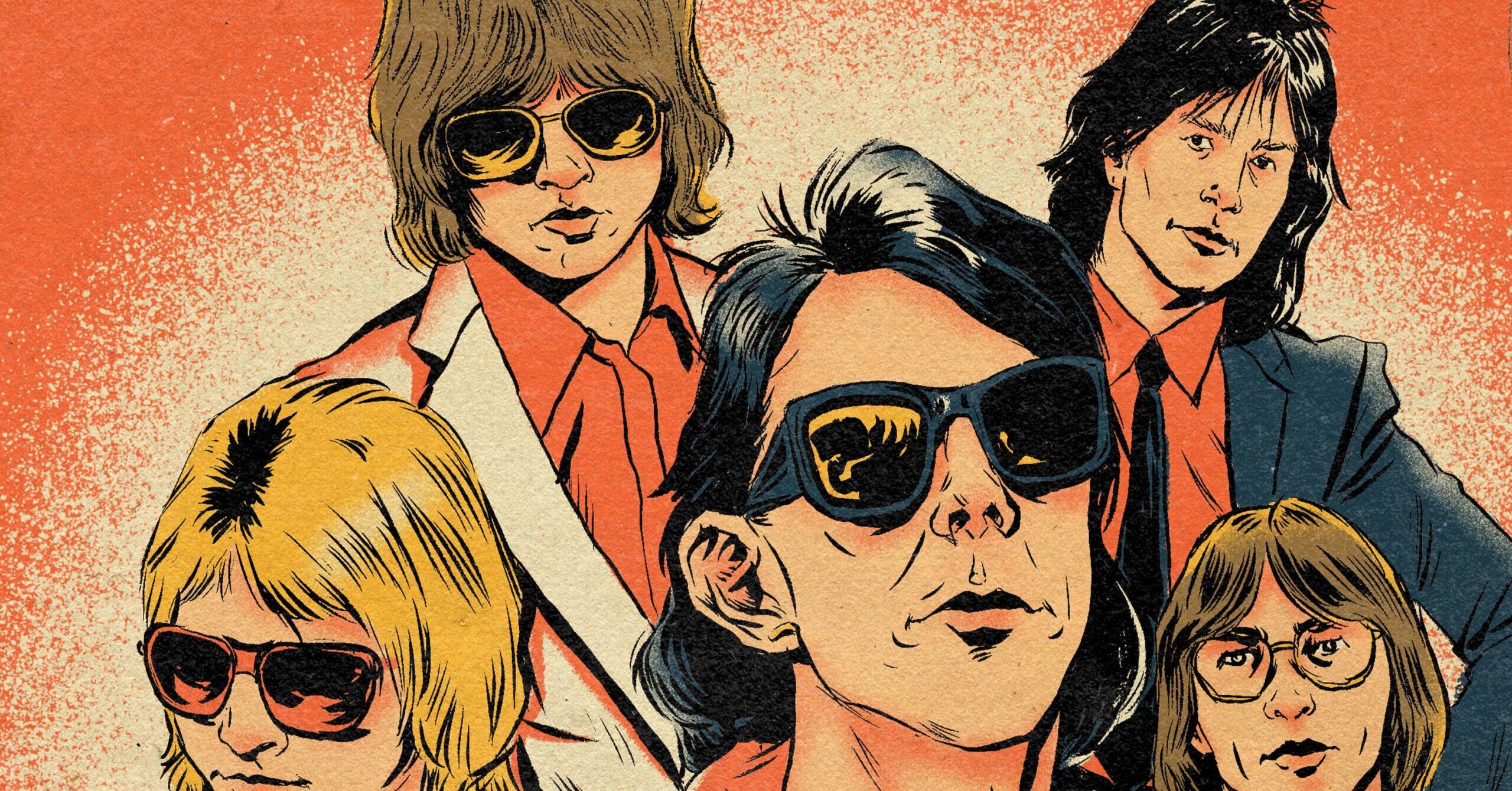
It was a moment like so many others in the history of the Rock & Roll Hall of Fame. A rock star in his 30s was onstage saying nice things about a band whose members were now in their 60s and 70s. As is custom, the guy onstage wore a sparkly jacket, and the men waiting to be inducted sported semi-convincing dye jobs and Austin Powers–looking suits. In this specific instance, the toastmaster was Brandon Flowers of the Killers, and the subject of his speech was one of the most popular (if not among the most acclaimed) groups of the late 1970s and early ’80s, the Cars.
“New Wave. Post-punk. Power pop. Tonight, they’re all riding together into the Rock & Roll Hall of Fame,” Flowers declared, exhibiting the same hype-man energy he’s applied to countless performances of “Mr. Brightside” in arenas all over the world. He then talked about their self-titled 1978 debut, a bedrock album for classic-rock radio stations for as long as there have been classic-rock radio stations. If you don’t think you know that record, it’s only because you didn’t catch the song titles when you heard them out in the wild at gas stations and baseball games. But if I hummed them for you, you’d recognize them instantly: “Good Times Roll,” “Just What I Needed,” “My Best Friend’s Girl,” “You’re All I’ve Got Tonight,” “Bye Bye Love,” “Moving in Stereo.” (That last one is forever associated with Phoebe Cates in the red bikini emerging from a swimming pool in Fast Times at Ridgemont High.) Then there are the scores of subsequent Cars hits: “Let’s Go,” “Shake It Up,” “Since You’re Gone,” “Magic,” “Drive,” “You Might Think,” and at least a half dozen others. In terms of music made by guitar-wielding white people born in the aftermath of World War II, the Cars are just about as ubiquitous as the Eagles or Fleetwood Mac, even if they don’t garner the same name recognition.
“On the back of what is now established as one of the greatest debut albums ever made, the Cars were named Best New Artist in the 1978 Rolling Stone Readers Poll,” Flowers reported that night back in 2018. “Forty years later, they still sound like a new band to me.”
I thought about that last statement as I was reading The Cars: Let the Stories Be Told, a new biography out this week by Bill Janovitz. Like the band he has chronicled, Janovitz is a musician from Boston. (His ’90s-era alt-rock band, Buffalo Tom, will be familiar to My So-Called Life fans.) For the book, he spoke with surviving band members Elliot Easton, Greg Hawkes, and David Robinson, as well as various disc jockeys, managers, girlfriends, wives, and hangers-on. He also culled archival comments from leader and primary songwriter Ric Ocasek (who died in 2019, about a year and a half after the Rock Hall induction) and foxy bassist and occasional singer Benjamin Orr (who passed in 2000).
Along with telling their story, Janovitz has also underlined the unsung importance of an American rock band that usually doesn’t come up in conversations about important American rock bands. And I appreciate that. Because the Cars did enough in their day to deserve one more victory lap. Let’s turn the ignition.
It might seem strange to describe a Rock & Roll Hall of Fame band as “unsung.” They certainly aren’t some obscure cult act: The Cars have sold 23 million albums in just the United States. (About a quarter of that is for the first record alone.) They have 13 Top 40 hits, and they were the first recipient of an MTV Video of the Year VMA, for 1984’s “You Might Think.” And then there’s the matter of their aforementioned classic-rock radio dominance, which might have had a detrimental impact on their legacy, depending on whether you view being put in the same context as REO Speedwagon and Styx as a good thing. (It’s not.)
It’s a weird place to be for someone like Ocasek, a Zelig-like figure who was producing records by Suicide and Bad Brains around the time he was starring in music videos with future wife and swimsuit model Paulina Porizkova. But that AOR/MOR image has flattened the Cars into a band that appears less interesting than they really are.
So, yes, while they were inducted into the Rock Hall, the timing of that induction offers a clue about how they are perceived. It occurred after their third nomination, 15 years after they were originally eligible, a sign of “respectable, but not absolutely essential” status. In their heyday, even as they were selling millions of records, they didn’t have the sort of romantic “cult of personality” worship afforded less successful contemporaries like the Ramones, Talking Heads, or the Clash. On the contrary, more than any other punk-adjacent band parceled into the more commercially acceptable “New Wave” category, the Cars were singled out for criticism as a too-slick pop sellout. One of those critics was Susan Orlean, who penned a skeptical profile for a Portland alt-weekly in the late ’70s, years before she became a literary celebrity. She characterized them as “a middle-brow retread of punk,” but the article’s snarkiest assessment came from Easton, who sarcastically (or not) described his band as “a calculated combination of coliseum rock and punk rock, designed to steal away children’s money.”
But while they did indeed “steal” a lot of money from kids at the time, they also never ascended to unquestioned “biggest band in the world” standing like the Police or (a little later) U2 and R.E.M. And no matter their reputation as early MTV pioneers, they didn’t have the visual appeal of Devo, the B-52’s, or Blondie. With the exceptions of Ocasek (a towering Ichabod Crane–type figure who looked like he could have been Joey Ramone’s older brother) and Orr (who was teen-idol cute well into his 30s), they were average-looking guys. (As drummer Robinson once remarked to critic Jon Pareles, “We played real good, but we looked real funny.”) Plus, they were notoriously boring as a live act; Janovitz quotes one early observer who calls them “the original shoegazers, but their songs were so good, it didn’t matter.”
Maybe the lack of an easily definable persona explains why some of the Cars’ innovations are sometimes credited to other acts, like how Gary Numan is praised for popularizing the melding of rock guitar and heavy drums with synthesizers (rather than Cars keyboardist Hawkes, their unassuming instrumental MVP) or how critics always reference Television’s Marquee Moon whenever a new indie band has a flashy lead guitar player but they never mention Easton, despite his similarly fluid solos on numerous FM radio classics. (The Strokes, for one, owe the Cars a royalty point or two.)
Which brings me back to Flowers: If saying that a classic-rock dinosaur still sounds like a new band seems like hyperbolic puffery, I’d argue it’s supported by the facts. In his speech, Flowers mentions discovering the Cars in 1994, a decade after the peak of their MTV popularity. The same year, Kurt Cobain opened his final Nirvana concert with a cover of “My Best Friend’s Girl,” one of the first songs he ever learned on a guitar. Two months after that show, Weezer released their self-titled debut, produced by Ocasek, which replicated the “heavy guitars plus synths” sound of the Cars for a new generation, inspiring a rising cohort of emo bands in the ’90s and beyond. About a decade after that, in the mid-aughts, Fountains of Wayne were even more overt about ripping off the Cars’ first album on their novelty hit “Stacy’s Mom,” while Flowers’s band, the Killers, mined their dreamier ’80s work. (That specific influence also extended to the alt-metal band Deftones, who covered the luminous ballad “Drive,” a top-three hit from 1984, on 2011’s Covers. In more recent years, that song has also been covered by Bleachers, Soccer Mommy, and Aimee Mann, among others.) About a decade after that, Car Seat Headrest straight up lifted the opening lines from “Just What I Needed” for 2016’s “Just What I Needed/Not Just What I Needed,” which caused some legal problems.
Listen to the Cars in 2025, and you’ll hear the accumulated history of 20th-century rock music—the elemental directness of Buddy Holly and Elvis records, the songwriting sturdiness of the Beatles and Beach Boys, the art-pop leanings of the Velvet Underground and Roxy Music, the electronic minimalism of Brian Eno and Kraftwerk, the arena-rock accessibility of Tom Petty and Cheap Trick. And you’ll also notice signs pointing to a lot of music that came after, including large swaths of indie, punk, and alternative rock.
It’s incredible how much new rock music still sounds like them—you hear traces of their synth-rock and pop-punk hybrids in everything from Olivia Rodrigo to sombr to the 1975. Even now, the Cars remain omnipresent. And kind of invisible.
If you want to hear how the Cars can evoke decades of rock history in just a single song, I advise queueing up “Just What I Needed.” I would suggest putting it on for any reason, really, as it happens to be a perfect rock song. Punchy, melodic, sexy, funny, and loaded with about a dozen different hooks (which is why it’s impossible to get sick of). It’s also ideal as a showcase for the Cars as a band. Each member gets a chance to shine: Orr handles the smoldering vocal, Easton plays an excellently florid solo, Hawkes slips in several brilliant synth accents, Robinson subtly changes up the beat two-thirds of the way in and almost steals the show, and Ocasek gets credit for writing and conceiving it all.
It sounds effortless on record, but “Just What I Needed” culminated more than a decade of musical wandering by the group’s two core members. Born Richard Theodore Otcasek in 1944, Ocasek first saw future bandmate Orr in 1965 on a local TV variety show in Cleveland, playing with a Beatles-esque combo called the Grasshoppers. They met sometime afterward, although they didn’t start playing together until three years later. They were, superficially, opposites—Ric was gawky, quiet, and prone to aloofness, while Ben was outgoing, warm, and a notorious ladies’ man, an image that became entrenched once he got famous. (On the back cover of 1979’s Candy-O, for example, the kittenish Orr seductively licks a lollipop, flipping the objectification taking place on the front cover. The cheesecake “sexy lady” images adorning Cars albums are the one aspect of their music that now seems dated.)
But no matter their personality differences, Ocasek and Orr were committed musical partners. Even as they cycled through different bands and musical styles, their dynamic remained essentially unchanged: Ric was the songwriter, and Ben was the star. But Orr always conceded when Ocasek opted to sing his own songs, even though Orr was the superior vocalist. (Complicating matters is the similarity of their voices—for years I thought that Ocasek sang “Just What I Needed,” not Orr.)
In the early ’70s, they drifted along with prevailing trends. In the band Milkwood, they played Laurel Canyon–style folk pop. In Cap’n Swing, they leaned into Steely Dan–inspired jazz rock. Along the way, Hawkes and Easton came into the fold, although it took the arrival of Robinson—a former member of the Modern Lovers, the crucial proto-punk outfit fronted by Jonathan Richman—to solidify the ensemble’s ultimate artistic identity. This coincided with Ocasek’s single-minded focus on writing brutally efficient songs that could become hits on the radio. He was, after all, a man in his mid-30s when he finally became a rock star, a fact that he tried to elide for much of his life.
In Janovitz’s book, Suicide’s Martin Rev recalls Ocasek telling him, “A hit song can be manufactured.” His thought process worked like this: “When people drive to work in the morning in their car, what’s going to get them to change the station? What’s going to get them to stay on the station the longest, so the ratings stay up?” Later, when the Cars became massive radio stars, songs like “Let’s Go” and “Shake It Up”—which are about as formulaic as “Cars-sounding” music gets—seemed like deliberate attempts to engineer hits, in the best possible sense. Like McDonald’s french fries, their deliciousness justified the public’s mass consumption.
That drive for pop success would eventually alienate the Cars from their anti-pop peers, including Gerald Casale of Devo, who admits to Janovitz that “we just thought the Cars were a cleaned-up commercial version of what we’d been doing.” (He also directed the band’s earliest music videos.) But this “cleaned-up” knock overlooks the thornier aspects of even their shiniest and most popular songs. Especially the lyrics, where time and again, Ocasek expressed ambivalence about the possibility of unconditional love. In “Just What I Needed,” he downplays his romantic interest with nonstop negging. (“I don’t mind you comin’ here / and wastin’ all my time.”) In “My Best Friend’s Girl,” he invents a scenario in which he ends up betrayed by those closest to him. (“She’s my best friend’s girl / But she used to be mine.”) A similar desperation is baked into the title of “You’re All I’ve Got Tonight,” which suggests only a fleeting connection predicated on emotional torture. (“You can knock me and I don’t care / Well, you can mock me, I don’t care.”) Even the deceptively cheery “Good Times Roll” carries a downbeat punch line to the titular exhortation (“Let the good times roll / Let them knock you around”).
Ocasek pinpointed this theme as “the act of not expecting” love songs. “I really don’t witness much love or emotion between people,” he once insisted. Instead, he viewed his music “as a way to get beyond loneliness. … Just turn on the radio and there it is: a sense of belonging. Without having to surrender to anybody else’s needs.”
The product of a lonely childhood shepherded by Czechoslovakian Catholic parents allergic to his artistic instincts, Ocasek’s own resistance to caring about “anybody else’s needs” would play out in sad and destructive ways in his private life. Like when he left his first wife and two children early on to pursue a music career. (Later, he cut his two oldest offspring out of his estate.) But on the Cars’ first album, that personal pain gave his pop-rock confections a necessary edge. Aiding him was producer Roy Thomas Baker, who at the time was best known for producing “Bohemian Rhapsody” and many other grandly excessive Queen songs. But with this new band, Baker wanted a change in direction.
“I had been doing Queen, which was kitchen-sink overproduction, which I loved,” he said in a 1999 interview. But he changed his mind after a confrontation by the Sex Pistols. Describing a scene that sounds like something out of a bad biopic, Baker recalled the punks saying, “All you bands are going to be gone because you’re overproduced.” So Baker toned it down on The Cars, bringing only his trademark multitracked backing vocals (most evident on “Good Times Roll”) to recordings that otherwise were grounded in a mix of old-school simplicity and cutting-edge technology.
It’s that combination of world-class production, aggressive but refined melodies, and barbed lyrics that’s been most influential for future generations. It’s not a coincidence that so many ’90s rock stars publicly pledged fealty to the Cars. Along with Nirvana and Weezer, there was Trent Reznor of Nine Inch Nails (who covered Ocasek’s solo number “Something to Grab For” in his pre-fame days), Hole (who employed Ocasek as a producer on 1996’s “Gold Dust Woman”), Smashing Pumpkins (who covered “You’re All I’ve Got Tonight,” also in 1996), No Doubt (who hired Ocasek to coproduce 2001’s Rock Steady), and members of Pearl Jam and the Red Hot Chili Peppers (who jammed together on “Just What I Needed” in 2019). The familiar tensions of the grunge era—that push-pull between pop and punk, emotional rawness and musical polish, the radio and the underground, all that art-vs.-commerce stuff—can be traced back to that first Cars album.
It’s telling that when Ocasek changed his name—which is pronounced o-KAY-sek, by the way—he altered it only a little bit. It was slightly easier to spell and say, but it was still an eccentric moniker. (Orr, meanwhile, had shortened his name from Orzechowski.) Front-loading a little weirdness in an otherwise accessible package was important to him. In that way, the Cars were alternative rock before alternative rock was a thing. No wonder Kurt Cobain felt safe retreating to “My Best Friend’s Girl” as his own career was spiraling. The Cars were, in a sense, home base.
If there’s a weakness to Janovitz’s book, it’s that the Cars’ story is conspicuously lacking in backstage sleaze and sizzle. They didn’t flame out in a haze of fame, addiction, and scandal, like so many other rock stars. Rather, they were waylaid by Def Leppard’s producer.
After making four albums that mostly stuck to the sound of the debut—their third LP, Panorama, is the outlier, a “screw the charts” move that resembles the chilly music Ocasek made with Suicide—the Cars pivoted big time with Heartbeat City, a glossy blockbuster with extremely 1984-sounding production helmed by Robert John “Mutt” Lange. An enigmatic South African who later married Shania Twain and oversaw her reign as the queen of arena country in the ’90s, Lange originally rose to prominence as the producer of AC/DC’s Back in Black, the impeccable hard-rock masterpiece supposedly used by recording engineers to test the acoustics of studio rooms.
Ocasek loved the guitar and drum sounds on that album, but by the time Lange entered the Cars’ orbit, he had moved on from the naturalness of Back in Black. After experiencing further success with Pyromania, Def Leppard’s diamond-selling pop-metal behemoth from 1983, he was now an even more extreme perfectionist than Roy Thomas Baker. As an associate explained to Janovitz, “Mutt’s whole thing was, ‘Kids these days don’t want to hear honky little snare drums. They’re all out watching Star Wars and having visual experiences, so let’s make records like that. Rather than going the natural route, let’s make something larger than life!’”
In pursuit of Star Wars–worthy scale, Lange kept the Cars in the studio for six punishing months as he micromanaged every aspect of the album. Rather than have the band record live, he would have each musician play their parts, dozens of times, separately. Over time, he put the sounds together on a grid like a giant puzzle, with sampled drums among the final elements slotted in the mix. It seems like the least fun way possible to make a record, although Lange’s hitmaking instincts were on point. This was most evident on “Drive,” which was initially conceived with a bossa nova rhythm that Lange excised in favor of a more atmospheric three–kick drum, one-snare beat. He also ran Orr through the paces of the vocal, paying extra close attention to his enunciation as he slowly pieced different takes together for a “perfect” performance.
“Drive” might have struck some fans of the early Cars records as a poppy bridge too far. (Robinson, for one, is still grumbling about it in Janovitz’s book.) But it now stands as their most enduring track, its big ’80s production in line with the Reagan-era revivalism that’s eternally in vogue in pop and indie music. (It’s one of those songs that explains Jack Antonoff’s whole production aesthetic.) In the music video, director Timothy Hutton—known for his role in Ordinary People—cuts between Orr and a narrative story line featuring Ocasek and Porizkova, who was 18 when she met her future husband. (He was 40.) But Orr is the star of the show, as he mimes his greatest and most celebrated vocal with unaffected, and undeniable, magnetism. (It’s no wonder he was later pegged to guest star on Miami Vice, which he bailed on to play Live Aid.)
The painstaking sessions for Heartbeat City were the beginning of the end for the Cars, although in the short term they paid big dividends. The album went quadruple platinum in the U.S., and it ushered them to MTV superstardom. This was also when I came to know their music, when I was a grade-schooler who saw Cars videos played amid clips by Madonna, Michael Jackson, Prince, Bruce Springsteen, and Van Halen. In that group, Ocasek’s detached stoicism stood out. (Along with David Byrne, he invented a new blueprint for “quirky” band leaders.) On-screen, his dry sense of humor was evident as he was transformed into a singing housefly in the “You Might Think” video and when he literally walked on water in “Magic.” As for the other Cars, they were harder to pick out; if you blinked while watching “You Might Think,” you might miss the tiny figures playing on a bar of soap while Ocasek buzzes around.
Behind the scenes, the same old resentments that typically derail rock bands had by now fully emerged. The band’s management gave Ocasek special treatment, and he ultimately declined to distribute his songwriting royalties equitably among his bandmates—always a leading cause of band breakups. Easton was a frequent foil; years later, after they had supposedly reconciled, Ocasek pointedly left him out of his acceptance speech at the Rock Hall ceremony, the only band member he neglected to mention.
And then there was Orr, his oldest and closest friend in the band. By 1987’s Door to Door, a lackluster Heartbeat City follow-up composed of songs that had been left off previous records, Orr was drinking heavily and isolating himself on tour, putting tinfoil on his hotel-room windows while brandishing a gun. By tour’s end, Ocasek was giving interviews in which he likened himself to Sting, who “had to leave the Police to really get noticed.” They announced their breakup early the following year.
In 2000, they gathered for their first group interview since their dissolution, for a DVD of live performances. When you watch the video, it’s impossible to pay attention to anybody but Orr, who looks terribly ill in an oversized Cleveland Browns shirt that hangs loosely on his gaunt frame. When asked whether he viewed himself as the “sexy” one in the band, Orr replies, poignantly, “It’s just a show, an act, and then you leave the stage, and you’re somebody else. But nobody else sees that except these guys and the crew. And that was terrifying.” He died from pancreatic cancer that October.
Ocasek always resisted re-forming the Cars, especially in the wake of Orr’s passing. Easton and Hawkes made the bizarre decision to tour with Todd Rundgren as the New Cars in 2005, which seemed like the final nail in the coffin. Incredibly, however, Ocasek eventually backtracked and spearheaded a solid reunion record, 2011’s Move Like This, which sounded more contemporary than you’d expect from a group their age. I interviewed Ocasek at that time, and he seemed content to let old wounds heal. “On this particular project, that baggage got lost,” he told me. “That baggage got lost at the airport.”
That quote sounds like one of his lyrics. The problem was that not all the baggage was his. (His longtime rival Easton, for one, hated Move Like This, citing the lack of guitar solos as a personal affront.) At home, Ocasek eventually grew estranged from Porizkova, and they separated in 2017. But while his former wife continued to care for him as a live-in roommate, he secretly conspired to cut her out of his will, citing “abandonment,” a term with devastating legal as well as emotional ramifications. Porizkova, ironically, was the one who discovered his body when he died at their home in September of 2019.
On the day of his funeral, she pondered a line from “Soon,” a standout ballad from Move Like This: “I know what I put you through.” Even after he died, in even the saddest circumstances, a Ric Ocasek song could feel brand-new. She used to be mine, indeed.



